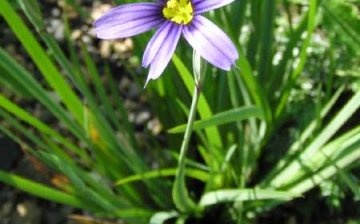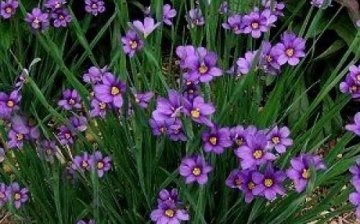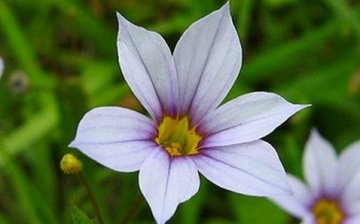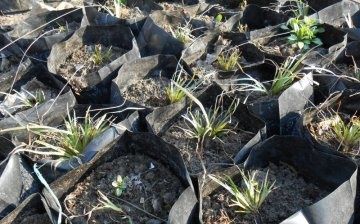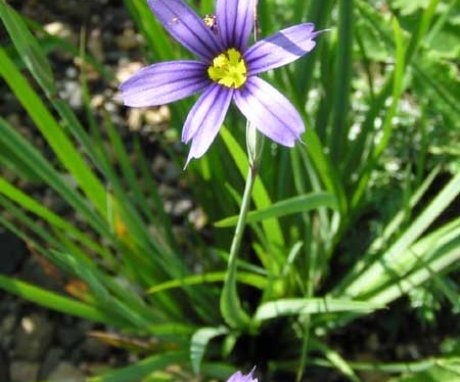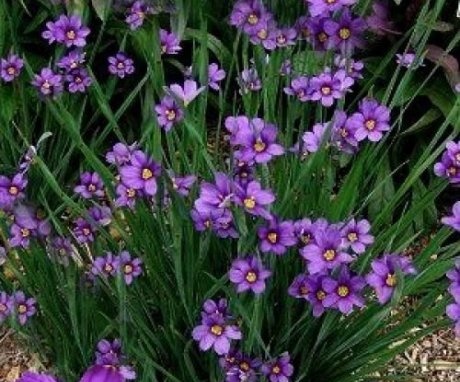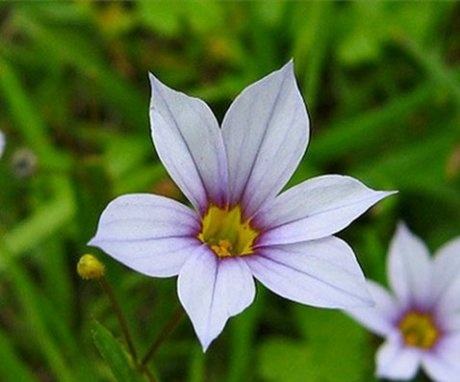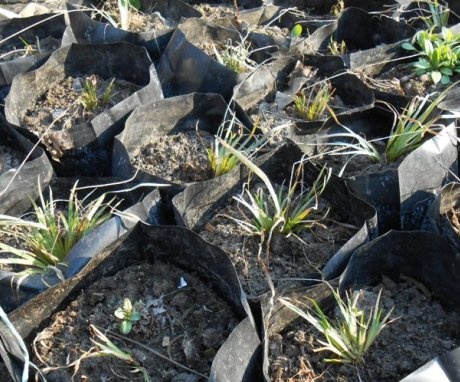Sisyurinhiy: species and their features, plant reproduction
For a long time, no one was engaged in sisyurinhiy and he grew up exclusively in the wild. Only at the beginning of the 20th century, the plant could already be found in Western Ukraine along the river banks. Later, gardeners began to pay attention to it and cultivate it in their gardens. Sisyurinhiy began to be used with group compositions and rockeries, combining with blue-eyed, hyacinths, forget-me-nots, etc.
Content:
- Description of the plant
- The most common types of sisyurinhia
- Reproduction and cultivation of sisyurinhia
Description of the plant
Sisyurinhiy is a herbaceous perennial plant, minimum height 10 cm, maximum 20 cm, leaves are long and narrow, like the stem, shoots are bright green.
Features of the plant:
- The height of the sisyurinchia leaves is slightly higher than the height of the stem, at the ends the leaves have bunches of small flowers.
- The inflorescence can be single, or it can be collected from 6 flowers.
- The flowers are blue-blue or blue-violet, the middle is yellow.
Depending on the type of plant, the color can vary significantly in saturation and tone.
When the buds of the sisyurinchia are fully opened, the inflorescences look like stars. Although the name of all flowers is common, some can be purple, some yellow and even white, the center is always contrasting. The variation is especially large in the South American regions.
Sisyurinhiy is a wild plant, in nature it is most common in America, both in the northern and southern parts of the mainland.
Sometimes sisyurinhiy confused with iris and for good reason, because both plants are related by origin. The miniature plant borrowed its xiphoid leaves from the iris family. Both iris and sisyurinhia have leaves fanning out from the base.
Not all types of sisyurinchia are perennial, but most are nevertheless. There are also annual plants and variegated forms, all this will be noted separately.
The most common types of sisyurinhia
Consider the types that are most common for breeding at home:
Sisyurinhiy narrow-leaved.
- Homeland - America, loves cracks in rocks, swamps, steppes, distributed from subtropical to warm-temperate climatic zone.
- Perennial plant, maximum height up to 20 cm, leaves are bright green, each stem ends with a blue-blue flower, either single or collected in an inflorescence, the center of the flower is yellow.
- It is also found in Transbaikalia, Russia, Australia, Western Europe.
- The brightest period of sisyurinhia is in late May-early June, when the plant is in full bloom.
- He is not picky in the soil, does not like the bright open sun.
- Every day one flower blooms, which wither in the evening, and the next day the cycle repeats
Sisyurinhiy Bermuda.
- The name comes from the original habitat of the plant, which appeared in the sands of Bermuda.
- The plant is perennial, sometimes the stem length reaches 60 m, it is winged and branched.
- The leaves have white edges.
- The flowers are 16 mm wide, they are dark blue with dark veins, the throat is yellow.
- The flowering period occurs in the spring, in the first year after sowing.
- If the temperature exceeds 21 degrees, then seedlings appear in three weeks.
- In cold winters, it can be annual.
Sisyurinhiy Douglas.
- It grows in meadows, it grows in both wet and dry conditions.
- The breadth of distribution is the same as that of the Californian.
- The stem grows taller than 30 cm, flattened.
- Lower leaves up to 20 cm long, bracts up to 10 cm.
- The flowers are bright red, there are also white, up to 2 cm in diameter.
- It begins to bloom earlier than other species: in early spring.
- In the CIS countries, it occurs in the steppe and broad-leaved areas.
Sisyurinhiy Californian.
- It grows from British Columbia to California.
- The plant is hard to endure the winter, so it needs to be provided with shelter.
- Loves fertile soil and sunlight.
- Annual plants quickly renew themselves by self-sowing.
- Perennial plant, maximum height 20 cm, leaves are wide, 15 cm long, yellow flowers open in late May and early June.
Sisyurinhia cereal grew in hot Chile.
- It begins to bloom in early spring.
- The stem height reaches 45 cm, it can be simple and branched.
- Leaves are short, up to 4 cm, flowers are yellow, in inflorescences from 4 to 8 pieces.
Sisyurinhiy swollen.
- Distributed in the western United States.
- The flowers are bright red with red anthers, blooming in March.
Sisyurinhiy cereal.
- The homeland of the plant is the USA and Canada, prefers meadows of any moisture.
- Cultivation in the steppe and broad-leaved zones of the CIS is recommended, although they have not been tested before.
- The maximum stem height is 60 cm, the leaves are narrow, the bracts are reddish.
- Blue flowers per inflorescence from 2 to 4, begin to bloom immediately after winter.
Sisyurinhiy pointed.
- It prefers meadows, fields and forests in the eastern United States and Canada, and massive turf grows from them.
- The flowers can be purple, blue, blue, the plant blooms in early spring.
- Cultivated in Sukhumi.
- The maximum stem height is 45 cm, the leaves are very thin, almost threadlike, the bracts are reddish.
Sisyurinhiy iris-leaved.
- Appeared in Chile and Brazil.
- The flowers are pale yellow in color, bloom in early spring.
- The winged stem grows up to 30 cm, the leaves are slightly shorter or equal in length to the stem.
Sisyurinhiy small-colored.
- Grows in Mexico, Brazil, Peru, less often in Australia.
- The flowers are pleasant creamy green, the eye is yellow.
- It begins to bloom in late spring, cultivated in Sukhumi.
- This is the tallest species, as the stem can reach a height of 100 cm.
Sisyurinhiy thin-leaved.
- It grows in the mountains of Mexico, the maximum height is 30 cm, it can be simple or branched.
- The flowers are yellow, not bright, begins to bloom in early spring.
- Cultivated in Stavropol and Nalchik.
Sisyurinhiy striped.
- Grew up in Argentina and Chile.
- The name comes from the variegated striped leaves.
- The flowers are pale yellow or cream, fully open by mid-summer.
- It is recommended to shelter in winter, cultivated in Dushanbe.
- The maximum plant height is 60 cm, and is one of the largest species.
- The foliage is faded, with a gray tint.
Reproduction and cultivation of sisyurinhia
If you like to experiment in your garden and there is an opportunity to get seeds of any type of sisyurinhia, then you should choose a plant depending on the desired composition, taking into account the shade of the plant's flowers and the flowering period.
Despite the fact that the homeland of Sisyurinhia America, which differs significantly from the Russian climate and conditions, the plant can still be cultivated in central Russia.
It tolerates winter easily even without special shelters, it is not afraid of high snow covers.
Shelter will be needed only in the case of an area with low snowfall and strong winds. Dry peat, spruce branches, dry tops, foliage can be used as a shelter.
The soil should be predominantly moist, it needs to be provided timely watering... This is due to the small length of the roots.
Reproduction is carried out by seeds:
- If the seeds themselves are placed in the ground, then this should be done in May, but it is better use seedlings.
- To get seedlings, seeds are planted between February and May at a depth of 4 mm.
- It is advisable to cover the soil with plastic wrap or glass; before the first shoots appear, the container with seeds should be in a warm place.
- In open ground or larger boxes of sisyurinchia can be planted after they reach a height of 5 cm.
- The distance between the shoots should be up to 40 cm.
The plant propagates easily and dividing the bush, thus, it easily tolerates a transplant and quickly takes root.
In order to prevent overgrowth of seedlings, it is necessary to cut the peduncles in a timely manner.
Why sisyurinhium is so similar to irises you can find out from the video.




